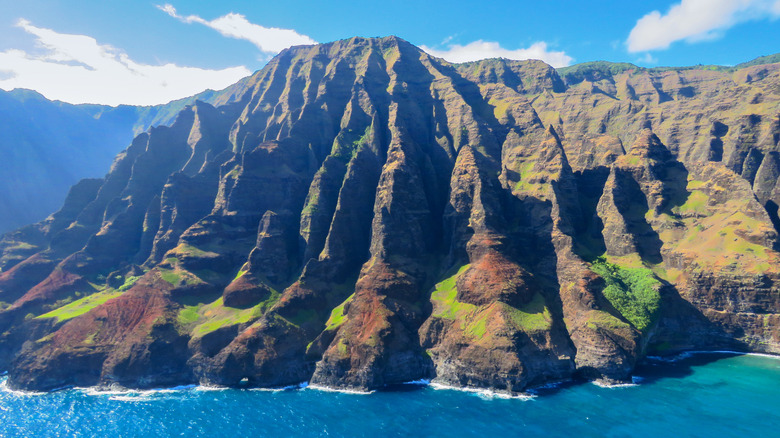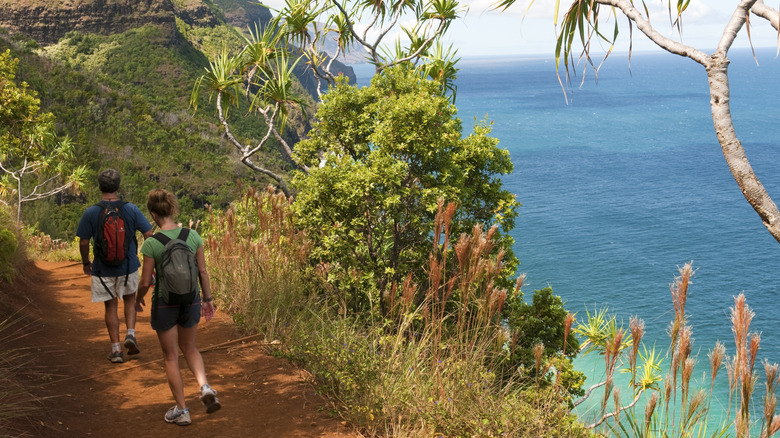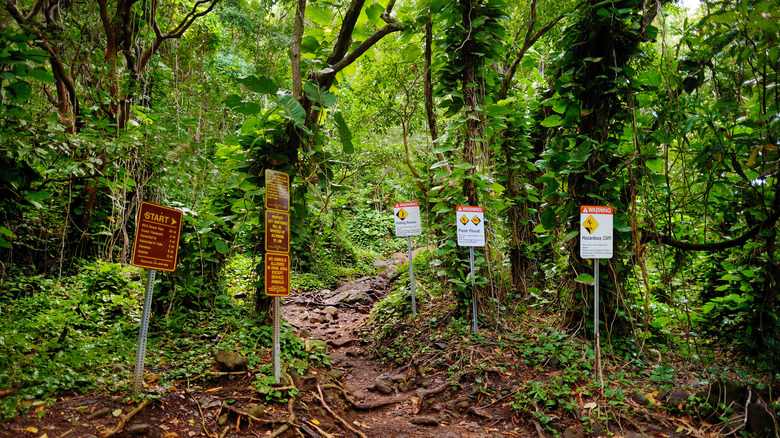This Hawaiian State Park Is A Great Destination For Hiking Adventures
If you're someone who loves to hike, The Nāpali Coast State Wilderness Park should definitely be a travel destination on your Hawaii bucket list. Found on Kauaʻi's northern shoreline, Nāpali's natural landscape is one of the most awe-inspiring sites on the island. Considering its location, Nāpali's striking topography is no shocker. Because Kauaʻi is the first island to have formed in Hawaii, it is the most biodiverse. Its lush, tropical forest intersected by an abundance of waterways makes this US state park a must-visit for nature lovers.
On the edges of this wilderness landscape, steep, 4,000-foot cliffs overlook the azure Hawaiian waters. This is one of the area's most prominent features. As a result, it is also the reserve's namesake, with "Pali" meaning "cliff" in Hawaiian. These dramatic geological formations look like they've come out of a movie. In fact, you might recognize them from their appearance as the iconic backdrop featured in the 1993 "Jurassic Park" film.
Not only does Nāpali's stunning scenery make it an idyllic place for hikers to explore, but this terrain is also perfectly suited for backpackers. Its long, winding trail path over the park's ridges and valleys provides great challenges for intermediate and experienced hikers.
Hiking in Nāpali Coast State Wilderness Park
Nāpali Coast State Wilderness Park is a vast 6,175 acres. However, to preserve the land and keep visitors safe, venturing off the designated trail is discouraged. Within this state park, there is one prominent trail — the Kalalau Trail. This world-famous hiking expedition traverses a 22-mile round trip from Ke'e Beach to Kalalau Beach. This journey is no joke and is only recommended for experienced, advanced hikers.
The trail weaves through five major valleys and barely has any flat breaks. You'll find yourself challenged with slippery, slim walkways and intense inclines. Additionally, the trail often borders sudden, towering drops. That said, the Kalalau Trail is not a plausible option for anyone afraid of heights. If you're in particularly good shape, the full round trip can be completed in about two days. However, while surrounded by unique and unparalleled beauty, you won't want to rush your way through this park.
If the Kalalau trail sounds a little (or a lot) more advanced than what you are prepared for, don't worry, there is an alternative. Many hikers will do the first 2 miles of the trail to Hanakāpī'ai Beach. Doing so, you'll still get to experience the rugged elegance of the Nāpali coastline, passing majestic sea caves, cascading waterfalls, and lush, verdant valleys. However, with a moderate incline and fewer cliffside trails, this portion is much more doable for an intermediate hiker or anyone scared of heights.
What to know before hiking the Kalalau Trail
Hiking the Kalalau Trail should not be an impulse, last-minute decision. Ahead of your trip, you will need to purchase an entry reservation and parking pass as visitor spaces are limited. If you plan to hike past Hanakāpī'ai Beach, you will be required to obtain a camping permit for Kalalau Valley.
Within Nāpali Coast State Wilderness Park, there are two campsites. One is at Kalalau Valley and the other is at Hanakoa Valley, about 6 miles from the start of the Kalalau trail. The camping permit for Kalalau Valley can be used for Hanakoa as well. However, if you plan to camp, you are only permitted to stay within the park for a total of five nights. Additionally, visitors are only allowed to camp at these two officially designated campsites. Note that once you are in the park, there is no drinking water or trash cans anywhere except at the trailhead in Hā'ena State Park. There is also no cell service inside Nāpali Coast State Wilderness Park.
The optimal time for hiking the Kalalau Trail is during the dry season from May to October when the weather is more stable. Winter months may bring heavier rainfall, leading to challenging trail conditions. Always ensure to check weather forecasts and trail conditions before heading out on your hike.


